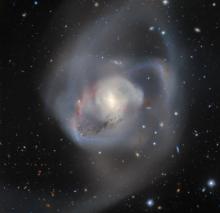Listen to today's episode of StarDate on the web the same day it airs in high-quality streaming audio without any extra ads or announcements. Choose a $8 one-month pass, or listen every day for a year for just $30.
You are here
Galactic Fireworks
NGC 6946 is the galactic equivalent of the Fourth of July – the source of a whole lot of fireworks. Over the last century or so, it’s produced more supernovas than any other galaxy. And surveys have revealed almost 200 possible supernova remnants – the remains of stars that exploded in the last few thousand years. So NGC 6946 is also known as the Fireworks Galaxy.
The galaxy is a beautiful spiral, like our home galaxy, the Milky Way. But it’s probably less than half the Milky Way’s diameter, with only a fraction as many stars. Yet it’s giving birth to many more stars than the Milky Way is.
Many of those stars are hot and massive. They burn out quickly, then explode as a supernova, shining brighter than billions of “normal” stars.
Supernovas are rare, though. On average, the Milky Way creates about one per century. And none has been seen here in four centuries. NGC 6946, on the other hand, has produced 10 of them since 1917.
And one other star in the galaxy should have exploded but didn’t. It was the type of star that ends its life as a supernova. Over the last decade it brightened a bit, then vanished. Only a small blob of infrared light remains. The star could have collapsed to form a black hole. The infrared light could come from material falling into it – more fireworks from the Fireworks Galaxy.
NGC 6946 is in the northeast before dawn, to the left of Deneb, the bright star at the tail of the swan.
Script by Damond Benningfield






